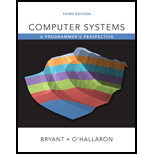
Computer Systems: A Programmer's Perspective Plus Mastering Engineering With Pearson Etext -- Access Card Package (3rd Edition)
3rd Edition
ISBN: 9780134123837
Author: Randal E. Bryant, David R. O'Hallaron
Publisher: PEARSON
expand_more
expand_more
format_list_bulleted
Concept explainers
Question
Chapter 5.12, Problem 5.10PP
A.
Program Plan Intro
Given C Code:
void copy_array(long *src, long *dest, long n)
{
long i;
for(i=0; i<n; i++)
dest[i] = src[i];
}
Cycles per element (CPE):
- The CPE denotes performance of program that helps in improving code.
- It helps to understand detailed level loop performance for an iterative
program. - It is appropriate for programs that use a repetitive computation.
- The processor’s activity sequencing is controlled by a clock that provides regular signal of some frequency.
B.
Program Plan Intro
Given C Code:
void copy_array(long *src, long *dest, long n)
{
long i;
for(i=0; i<n; i++)
dest[i] = src[i];
}
Cycles per element (CPE):
- The CPE denotes performance of program that helps in improving code.
- It helps to understand detailed level loop performance for an iterative program.
- It is appropriate for programs that use a repetitive computation.
- The processor’s activity sequencing is controlled by a clock that provides regular signal of some frequency.
C.
Program Plan Intro
Given C Code:
void copy_array(long *src, long *dest, long n)
{
long i;
for(i=0; i<n; i++)
dest[i] = src[i];
}
Cycles per element (CPE):
- The CPE denotes performance of program that helps in improving code.
- It helps to understand detailed level loop performance for an iterative program.
- It is appropriate for programs that use a repetitive computation.
- The processor’s activity sequencing is controlled by a clock that provides regular signal of some frequency.
D.
Program Plan Intro
Given C Code:
void copy_array(long *src, long *dest, long n)
{
long i;
for(i=0; i<n; i++)
dest[i] = src[i];
}
Cycles per element (CPE):
- The CPE denotes performance of program that helps in improving code.
- It helps to understand detailed level loop performance for an iterative program.
- It is appropriate for programs that use a repetitive computation.
- The processor’s activity sequencing is controlled by a clock that provides regular signal of some frequency.
Expert Solution & Answer
Want to see the full answer?
Check out a sample textbook solution
Students have asked these similar questions
Write the SQL code that permits to implement the tables: Student and Transcript. NB: Add the constraints on the attributes – keys and other.
Draw an ERD that will involve the entity types: Professor, Student, Department and Course. Be sure to add relationship types, key attributes, attributes and multiplicity on the ERD.
Draw an ERD that represents a book in a library system. Be sure to add relationship types, key attributes, attributes and multiplicity on the ERD.
Chapter 5 Solutions
Computer Systems: A Programmer's Perspective Plus Mastering Engineering With Pearson Etext -- Access Card Package (3rd Edition)
Knowledge Booster
Learn more about
Need a deep-dive on the concept behind this application? Look no further. Learn more about this topic, computer-science and related others by exploring similar questions and additional content below.Similar questions
- 2:21 m Ο 21% AlmaNet WE ARE HIRING Experienced Freshers Salesforce Platform Developer APPLY NOW SEND YOUR CV: Email: hr.almanet@gmail.com Contact: +91 6264643660 Visit: www.almanet.in Locations: India, USA, UK, Vietnam (Remote & Hybrid Options Available)arrow_forwardProvide a detailed explanation of the architecture on the diagramarrow_forwardhello please explain the architecture in the diagram below. thanks youarrow_forward
- Complete the JavaScript function addPixels () to calculate the sum of pixelAmount and the given element's cssProperty value, and return the new "px" value. Ex: If helloElem's width is 150px, then calling addPixels (hello Elem, "width", 50) should return 150px + 50px = "200px". SHOW EXPECTED HTML JavaScript 1 function addPixels (element, cssProperty, pixelAmount) { 2 3 /* Your solution goes here *1 4 } 5 6 const helloElem = document.querySelector("# helloMessage"); 7 const newVal = addPixels (helloElem, "width", 50); 8 helloElem.style.setProperty("width", newVal); [arrow_forwardSolve in MATLABarrow_forwardHello please look at the attached picture. I need an detailed explanation of the architecturearrow_forward
- Information Security Risk and Vulnerability Assessment 1- Which TCP/IP protocol is used to convert the IP address to the Mac address? Explain 2-What popular switch feature allows you to create communication boundaries between systems connected to the switch3- what types of vulnerability directly related to the programmer of the software?4- Who ensures the entity implements appropriate security controls to protect an asset? Please do not use AI and add refrencearrow_forwardFind the voltage V0 across the 4K resistor using the mesh method or nodal analysis. Note: I have already simulated it and the value it should give is -1.714Varrow_forwardResolver por superposicionarrow_forward
- Describe three (3) Multiplexing techniques common for fiber optic linksarrow_forwardCould you help me to know features of the following concepts: - commercial CA - memory integrity - WMI filterarrow_forwardBriefly describe the issues involved in using ATM technology in Local Area Networksarrow_forward
arrow_back_ios
SEE MORE QUESTIONS
arrow_forward_ios
Recommended textbooks for you
 C++ for Engineers and ScientistsComputer ScienceISBN:9781133187844Author:Bronson, Gary J.Publisher:Course Technology Ptr
C++ for Engineers and ScientistsComputer ScienceISBN:9781133187844Author:Bronson, Gary J.Publisher:Course Technology Ptr C++ Programming: From Problem Analysis to Program...Computer ScienceISBN:9781337102087Author:D. S. MalikPublisher:Cengage Learning
C++ Programming: From Problem Analysis to Program...Computer ScienceISBN:9781337102087Author:D. S. MalikPublisher:Cengage Learning Systems ArchitectureComputer ScienceISBN:9781305080195Author:Stephen D. BurdPublisher:Cengage Learning
Systems ArchitectureComputer ScienceISBN:9781305080195Author:Stephen D. BurdPublisher:Cengage Learning

C++ for Engineers and Scientists
Computer Science
ISBN:9781133187844
Author:Bronson, Gary J.
Publisher:Course Technology Ptr

C++ Programming: From Problem Analysis to Program...
Computer Science
ISBN:9781337102087
Author:D. S. Malik
Publisher:Cengage Learning

Systems Architecture
Computer Science
ISBN:9781305080195
Author:Stephen D. Burd
Publisher:Cengage Learning